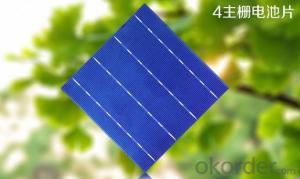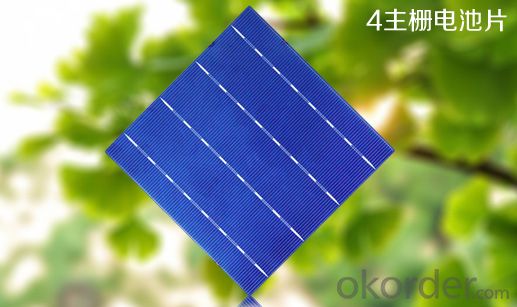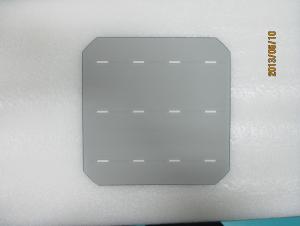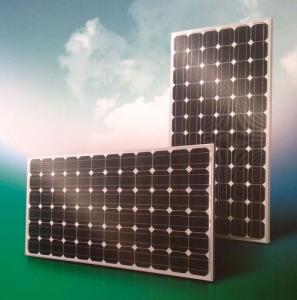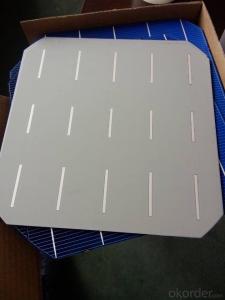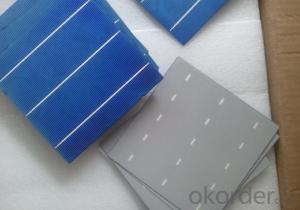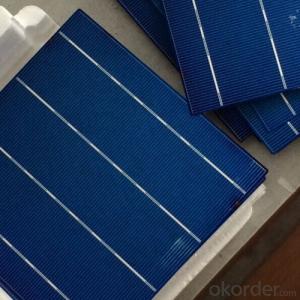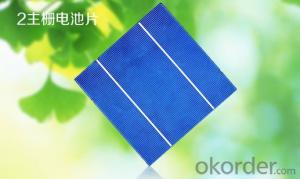High Efficiency PV Poly 4BB Solar Cells
- Loading Port:
- China Main Port
- Payment Terms:
- TT OR LC
- Min Order Qty:
- -
- Supply Capability:
- -
OKorder Service Pledge
Quality Product, Order Online Tracking, Timely Delivery
OKorder Financial Service
Credit Rating, Credit Services, Credit Purchasing
You Might Also Like
our cells special features:
1. High conversion efficiencies resulting in superior power output performance
2.Outstanding power output even in low light or high temperature conditions
3.Optimized design for ease of soldering and lamination
4.Long-term stability,reliability and performance
5.For 156P poly cells with high efficiency in photovoltaic conversion 16.3%-17.5%.
6.Low inverse current, high shunt resistance and high dependability.
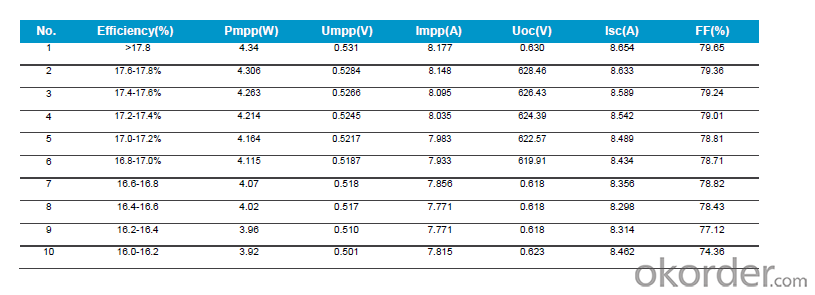
- Q: Can solar cells be used for off-grid power supply?
- Yes, solar cells can be used for off-grid power supply. Solar cells, also known as photovoltaic cells, convert sunlight directly into electricity. This makes them an excellent choice for powering off-grid locations where access to traditional power sources may be limited or unavailable. Solar panels can be installed in remote areas to generate electricity, providing a sustainable and renewable energy solution for off-grid power supply.
- Q: Can solar cells be used in mobile devices?
- Yes, solar cells can be used in mobile devices. In fact, many modern smartphones and tablets are equipped with solar panels or have the capability to be charged using solar energy. This allows for increased energy efficiency and convenience, especially when used in outdoor or remote locations.
- Q: How to make solar cells in a scientific way?
- Follow the scientific instructions, then you will learn how to make it.
- Q: Can solar cells be used in shopping centers?
- Yes, solar cells can be used in shopping centers. They can be installed on the rooftops or in parking lots to generate clean and renewable energy to power the shopping center's operations. Solar cells provide cost savings on electricity bills and reduce carbon emissions, making them an environmentally friendly choice for shopping centers.
- Q: How do solar cells perform in areas with high levels of salt spray?
- Solar cells generally do not perform well in areas with high levels of salt spray. The salt particles can accumulate on the surface of the solar cells, reducing their efficiency by blocking sunlight and corroding the electrical components. Regular cleaning and maintenance are required to mitigate the negative impacts of salt spray on solar panels in such areas.
- Q: What is the history of solar cell development?
- The history of solar cell development can be traced back to the 19th century, with the discovery of the photovoltaic effect by French physicist Alexandre-Edmond Becquerel in 1839. However, it wasn't until the mid-20th century that significant advancements were made in solar cell technology. In 1954, Bell Labs introduced the first practical silicon solar cell, which had an efficiency of around 6%. Over the years, research and development efforts focused on improving efficiency, reducing costs, and exploring alternative materials. In the 1970s, solar cells started being used in space applications, such as powering satellites. In the 1990s, innovations like thin-film solar cells and multi-junction cells further expanded the possibilities of solar energy. Today, solar cells have become increasingly efficient, affordable, and widely adopted, playing a vital role in the transition to clean and renewable energy sources.
- Q: How do solar cells perform in areas with high levels of air pollution?
- Solar cells can be affected by high levels of air pollution as it can reduce their efficiency. The presence of pollutants in the air can decrease the amount of sunlight reaching the solar cells, leading to a decrease in their overall performance. Additionally, pollutants such as dust, soot, and smog can accumulate on the surface of the solar panels, further reducing their efficiency by blocking and scattering sunlight. Therefore, in areas with high air pollution, solar cells may not be able to perform at their optimal levels and may require more frequent cleaning and maintenance to ensure their effectiveness.
- Q: Can solar cells be used in public transportation systems?
- Yes, solar cells can be used in public transportation systems. They can be installed on the roofs of buses, trains, and trams to generate electricity from sunlight, which can be used to power various systems such as lighting, air conditioning, and onboard electronics. This helps reduce reliance on fossil fuels and lowers the carbon footprint of public transportation. Additionally, solar cells can also be integrated into bus shelters and charging stations to provide clean energy for electric buses and other vehicles.
- Q: Is the Photovoltaic Cells cheap to buy?
- It used to be very expensive around 35 years ago because of all the labor cost and R&D expense, but now it is not as expensive as before.
- Q: How do solar cells work to become the solar energy?
- The solar cells work by using the solar power from sunshine to generate the energy such as electricity to become solar energy.
Send your message to us
High Efficiency PV Poly 4BB Solar Cells
- Loading Port:
- China Main Port
- Payment Terms:
- TT OR LC
- Min Order Qty:
- -
- Supply Capability:
- -
OKorder Service Pledge
Quality Product, Order Online Tracking, Timely Delivery
OKorder Financial Service
Credit Rating, Credit Services, Credit Purchasing
Similar products
Hot products
Hot Searches
Related keywords
